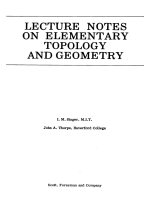- Trang chủ >>
- Khoa Học Tự Nhiên >>
- Vật lý
Notes on thermodynamics and statistics
Bạn đang xem bản rút gọn của tài liệu. Xem và tải ngay bản đầy đủ của tài liệu tại đây (6.19 MB, 200 trang )
NUNC COCNOSCO EX PARTE
TRENT UNIVERSITY
LIBRARY
Notes on
Thermodynamics
and Statistics
Digitized by the Internet Archive
in 2019 with funding from
Kahle/Austin Foundation
/>
Notes on
Thermodynamics
and Statistics
ENRICO FERMI
THE UNIVERSITY OF CHICAGO PRESS
CHICAGO
&
LONDON
vv
V
<
V\
(o <o>
Library of Congress Catalog Card Number: 66-20581
The University of Chicago Press, Chicago & London
The University of Toronto Press, Toronto 5, Canada
© 1966 by The University of Chicago. All rights reserved
Published 1966. Printed in the United States of America
PREFACE
Enrico Fermi was all his life a devoted and very successful
teacher. Not only did he fulfill his academic duties with great
thoroughness and diligence, but he made a real effort to present
physics in a clear, simple, easy way. This apparent simplicity
often was the result of deep meditation on his part, started in
early youth, when he was his own pupil. There is a record of this
work in his own notebooks, in his published textbooks, and in his
original papers, as can be traced by a perusal of the Collected
Papers.
Fermi taught at one time or another almost all of physics.
When he gave courses he prepared notes for his own use, and
sometimes he made them available to his students. Several of
these sets of notes are preserved. The Notes on Quantum Mechanics
were published by the University of Chicago Press in 1961. They
represent the last version of Fermi’s presentation of this subject
as it evolved from around 1928 to 1953. Apparently they have
been useful to students and teachers alike.
The set of notes here presented served for a course in thermo¬
dynamics given in 1951-52, two years before his death. They
cover thermodynamics and statistical mechanics. The notes were
not destined for publication and they are not intended to be a
book on the subject. The reason for publishing them is that it is
thought they still might be very useful to a student reviewing or
to a professor preparing to give a course on the subject. The
choice of material, the emphasis, and the mode of presentation by
such a master as Fermi will be worth studying for a long time.
E.
Segre
Berkeley, California
v
95392
CONTENTS
State of a System.
1. State of a System.
2. Ideal Gases.
First
3.
4.
5.
j
3
3
Law of Thermodynamics.
7
First Law of Thermodynamics.
9
Specific Heats.
H
Adiabatic Transformation.13
Second Law of Thermodynamics.15
6. Second Law of Thermodynamics.17
7. Carnot Cycle.lg
8. Absolute Temperature.20
9. Entropy.22
10. Entropy of p-V-T Systems.25
11. Clapeyron Equation.27
12. Van der Waals Equation.28
Boltzmann Distribution.31
13. The Phase Space.33
14. Probability of a Distribution—Boltzmann Distribution
.
35
15. Equipartition of Kinetic Energy.36
16. Maxwell Distribution and Barometric Distribution
...
37
17. Proof that/3 Is the Same for Two Substances in Contact .
.
39
18. Entropy and Probability.40
Thermodynamic Functions.41
19. Helmholtz Free Energy.43
20. State Sum Z and Free Energy.47
21. Thermodynamic Potential at Constant Pressure
....
48
22. Phase Rule.51
Thermodynamics of Solutions.53
23. Thermodynamic Functions of Dilute Solutions.55
24. Osmotic Pressure.58
25. Chemical Equilibria in Solutions.59
26. Debye-Hueckel Theory.61
27. Distribution of a Solute between Two Solvents.63
28. Vapor Pressure, Boiling and Freezing Points of Solutions .
.
64
Quasi-ergodic Systems.67
29. Stationary Distribution for a Quasi-ergodic System
...
69
30. Temperature Equilibrium from Statistical Distribution
.
70
31. Boltzmann Distribution.73
32. Adiabatic Invariance of Q(E).75
33. Thermodynamic Functions and Phase Space Interpretation
76
Statistical Distribution of Quantized Systems.79
34. Boltzmann Distribution for Quantized Systems.81
35. Application to Atoms and Molecules.82
36. State Sum for Quantized Systems—Thermodynamic Functions
84
vii
37.
38.
39.
40.
41.
86
88
The Oscillator
.
.
•
•
•
Specific Heat of Solids ...
Thermodynamics of Radiation
Planck’s Formula
■
•
Radiative Transitions of an Atom
Thermodynamics of Magnetization
99
..
42. Statistical Theory of Paramagnetism
43. Weiss Theory of Ferromagnetism ..
44. Thermodynamics of Magnetization-
conductivity
91
96
98
101
104
Applicati on to Super
.
45. Paramagnetic Cooling
.
Third Law of Thermodynamics ....
46.
47.
48.
49.
50.
51.
52.
53.
54.
Third Law of Thermodynamics
.
.
Entropy of Solids..
Quantization of Molecular Translation
Sackur-Tetrode Formula
• ; .•
Vapor Pressure of a Solid and a Liquid
Thermoionic Effect.
Entropy of a Diatomic Gas
Gaseous Reactions.
Ionization Equilibrium in a Gas .
General Methods of Statistical Mechanics
55. New Discussion of Boltzmann Distribution
56. Thermodynamical Relationships for Macroscopic Syste ms
57. The Grand Canonical Ensemble
The Quantum Statistics
58.
59.
60.
61.
62.
63.
64.
65.
66.
67.
68.
.
Systems with Identical Particles .
Bose-Einstein Statistics.
Fermi Statistics.
Probabilities of Transition and Statistics
Black Body Radiation from B. E. Statistics
The Bose-Einstein Gas.
Helium II.
Fermi Gas.
Case of Complete Degeneracy ....
Statistical Atom.
Electrons in Metals.
Miscellaneous Applications
69.
70.
71.
72.
73.
74.
Vacuum and Radiations
Matter in Unusual Conditions
Thermonuclear Reactions .
Stellar Equilibria
White Dwarfs
....
Turbulence.
vm
105
107
111
113
114
116
117
120
121
122
123
126
127
129
132
135
139
141
142
144
146
148
149
152
154
158
159
163
167
169
171
174
177
179
181
State of a System
Stojfcz-
0-
j
Af
C^*$ Cl^-A**'0/^'
W&chuu^tjJl /i/CJZ'tJ2-*A*££^
l
/wC
/U-*-'
\r~'^ ^
&■— ^ La-O
?r
X&a%A^(\
^^(Kyt^/bty^
-it
blAsb
v y\ ■'j
l?hX^(j!s\/'aA'*2'^/^
Py/y\rvJj^-sj~-Q^
(W^C^tu />^
PjJU
'tlju i/nXXXc^Os^ ^
I0
4M~
y^a^X^tiiLy) ^ b+2n+--j/4 —
CO-K^h
£a/W
d-
t'/^(J2slsCO**43
'VAJ^ixy\*Aj{jL^rv^
{tff P>-\c&-
^t-<_
'Wr..
<
Mdb^cJUst f btc.. J
i/U,
XU, aXJjL
^J^AA~ ~~~‘
^-\ (XJ^-]jJx.
^X
Y<^J Po
(JJJj^
JX^UJ-'
0^>tyL^
A^Jdw
dXjju ^ ft-
%KJL
^
(PjXfay^_.\s^^t
dp
^
^ f-^cyuy' cAjUsc^c^
yp
j2AJ^SUXyu
$1^2^
pAjJ^^
8^.. Jj ^^AJ^aTpJ^ ^ C^f /2^o
^Ak^Zm^-
t^ ^
IVtr^
JLr*^t^ysvJUru-4
1
A^Aaa pL° ^A (yL°<^y~ &A A~^~<
^
^ ^
/iA^AA-*-*-\£'d-'
^aL. .
^
'
« / /»
.
L- J^17
CajAsa I [\J O'~l/f<
(x/~l/^k^ ^
l
\j
X
<£ Qs
C' f- u
^
1
z
'
y
h.Jl vn ir
>V=
%
z
1^[jLtn^
in c. x c. •=. p.
X.x. = IF^i
\^]AyL(AA^J2_^ l
y‘ '4-
^
Z” ^
K ■+
Z F.x-
=£
(VL,
fW
He-
-1 F.-K
-
7j> r' of ^
—
(° j &
P r- ^
V-r^3
=
V - i: F
K
A/V^~
"
Z^-L.
gXfFI^uC. yn/lS-4
j
ipfjLsJ!-
OnSL&4 ,
o^c,O-^.
sjyf ^usJju
/JUL
zL
-2aasJ
fl-v'MMy
T~ t-t 113.16
/ -derz,
\j = RT
1 (V/
2:
2
/r
-f — r
l
IV
°Z5~4k/f£ .
.
- - At izin^A^uA
Z
7
R,=(f.v£t ± . etotyio
oooot yx to
^(/.3<?£>26 t
iTU^
/A%)a /o2i ^
\ A (A^)i\y^n^iZ^irM.
1>T
'/£
/^U-t .
ZZZZjzZ^iLJ^^ynzL^
3
X
ZZ-Jj^uZ
•f ■i'.
n
Z'Z^aZ^'Z^CkZ
-f ,£ T
/e, , = 2
z
Z ^~f
^
* I
n
2.
'Ir^ji.e^cA ‘*1^
i- l^ii)
Ft
-^
t'VvA-' (^s\sG<.
w q.
U Tc
-
IT
-
t^T!^
p- y. =
3Lt
'
«r
'XA^yixru^iV
j(4vfc
1/
.
0^-
J_
f.jw-- ZLT-iL
Z-2VVZ_f±
w-JjpMV
M
V'
M
^
2.
First Law of Thermodynamics
3-£L.
Hj^Lo^CcJ.
&’>^-4£sis-tCh^^
'iU^sjX^AAAAi/ rU-'O**'
&-s>-'***4
UA =
ujyia^-
%
/U*s tZ^^tyC)
h
yu^^^S---
U»~U^L
ILU'
Y^U
3SX^JtJ'y-uL^-l^Jt^yt^yt
^t
L0,«
L
~A
fJU^pltl^t ^ !^L —
j.
-t3~tl-&' T(T~L.
\jj
L0^A
<* =
vA-~
E.fyfi-'
0,
Uq - o
V
L—
c/j^-<_aa3. ls-*j-rx.
/1^aO
<^£y\s+/
t^fAjUt,
£mXiaj/j_
th^LAA^tA^
’
“
;:
^6
r
^A6
^7UvU^d^v-4A^^> /1m^
(xJM' \m3L, UvaJC>aJ^
V, j3^c^y~i_<,«y .
rMuk> }) !^nj^^j 9r ^5. t^Jiodx^
L
3-^
a s ~r"
H1"
£x M/j. ; Sj^X u^U
*-
^
•4^
1
X
1
X^ tVUA . ^ 'JU
/
y ^^U"
’ths*AAs%.L-rf/t- ^
bj
Hk4/X&$XhM o'X'UlSL.
Ia-clSC .
Xfc-SU^X
tJ ■u^jL
^Ui
<-
-^XLcn^
Imo^. 1/f*^ ^
> 'mw^
V
AU + L - o
^-77
^
/
y)
pX~L,
A*^U-
^U/lyt^^AyfevL
,
4l>tL=®
:
/
awt. p/ £wj^x^ Oe-d,.
A
0
Q - CbvXyt ^
A m--,
~
77^/
tnAbi.
= - L +(Q
Xjl^X
rui£jiZ-JO-z-*X
guX^y^j
Su^-v-^j
C/{u*i*s~y
'Us^r~ufc-
^~
if £ ifc.
1
ul: 4-IS" 0> lo”1 JU^/>
- 10 -
§j\J-^Axa/Cj
l/,
) l°r >
f
Vif>
ddu>
d(Q- o(U + h dy -
r
f - I-)
Vrl
"JtH-c'A—
IVl^
\lAS!
^Lo-u^
A + £>
-U-O UjL*jfc
t?^.
A
<^£o
C<^A^t
Asu^o
C
tf - lo
FM^
■
—
V
U = cvT
f>V - RT
(CytfLjolT-VJf>
cjT ^ I? J V
C, = C^+P,
J-= ^ =
c (T
Ka'^p)Cct-
1+ f
c tr
\^cru<-^-as^o-
Aaa^Pj\.
C
^ iRT
C
^ f RT
ir
r
-
z
R
= £ &
"
cLir - ^z Nz
12 -
r"
r- t
n
;
c'•f = ~Z £ ) 9r-—s*
5
Ctct-
~“
5~-4~
dQ - rJ U +1* olV - o
— o/T +
n
U
(/
(jlj- + b)ol\/*o
7*
UjloJL
'ir
«ITt
^
T V^ *r~u
f
^
r
til
T ^ i>
r
55x = 5*1/
v\
1T4Xu.^ coj 5
^T
=
Y*j 4
l
irtoi
Jl
T
4-
$-
r IxM ^
ip Aw,
1
fcw
.y/o.
2. '
. Lfe-
ZT
t
^
^ SV
X
i.
IVa^
JlA^J^yxy^j
T-v 1/ J
v ' £^i'
l/^
-
13
-






![Lecture notes on c algebras and quantum mechanics [jnl article] n lamdsman](https://media.store123doc.com/images/document/14/rc/rt/medium_6PjfnHupCQ.jpg)


